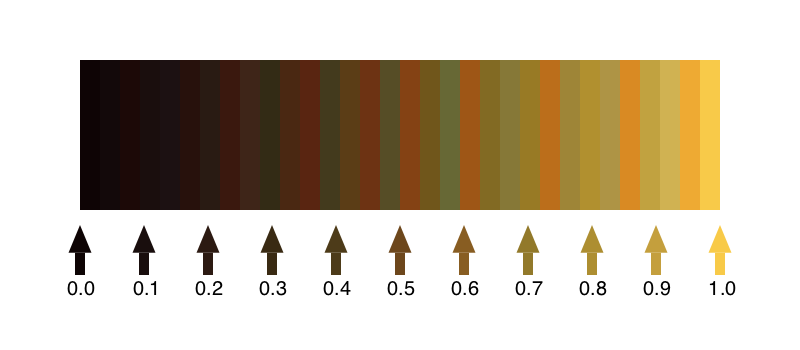Basics
A colorscheme is an array of colors:
32-element Array{RGB{Float64},1}:
RGB{Float64}(0.0548203,0.016509,0.0193152)
RGB{Float64}(0.0750816,0.0341102,0.0397083)
RGB{Float64}(0.10885,0.0336675,0.0261204)
RGB{Float64}(0.100251,0.0534243,0.0497594)
...
RGB{Float64}(0.85004,0.540122,0.136212)
RGB{Float64}(0.757552,0.633425,0.251451)
RGB{Float64}(0.816472,0.697015,0.322421)
RGB{Float64}(0.933027,0.665164,0.198652)
RGB{Float64}(0.972441,0.790701,0.285136)The names of the built-in colorschemes are stored in the schemes array:
julia> schemes
336-element Array{Symbol,1}:
:alpine
:aquamarine
:army
:atlantic
:aurora
:autumn
:avocado
:beach
:blackbody
...
:PiYG_10
:PiYG_11
:magma
:inferno
:plasma
:viridisTo access one of these built-in colorschemes, use its symbol:
julia> ColorSchemes.leonardo
32-element Array{RGB{Float64},1}:
RGB{Float64}(0.0548203,0.016509,0.0193152)
RGB{Float64}(0.0750816,0.0341102,0.0397083)
RGB{Float64}(0.10885,0.0336675,0.0261204)
RGB{Float64}(0.100251,0.0534243,0.0497594)
...
RGB{Float64}(0.620187,0.522792,0.216707)
RGB{Float64}(0.692905,0.56631,0.185515)
RGB{Float64}(0.681411,0.58149,0.270391)
RGB{Float64}(0.85004,0.540122,0.136212)
RGB{Float64}(0.757552,0.633425,0.251451)
RGB{Float64}(0.816472,0.697015,0.322421)
RGB{Float64}(0.933027,0.665164,0.198652)
RGB{Float64}(0.972441,0.790701,0.285136)
By default, the names of the colorschemes aren't imported (there are rather a lot of them). But to avoid using the prefixes, you can import the ones that you want:
julia> import ColorSchemes.leonardo
julia> leonardo
32-element Array{RGB{Float64},1}:
RGB{Float64}(0.0548203,0.016509,0.0193152)
RGB{Float64}(0.0750816,0.0341102,0.0397083)
RGB{Float64}(0.10885,0.0336675,0.0261204)
RGB{Float64}(0.100251,0.0534243,0.0497594)
...
RGB{Float64}(0.757552,0.633425,0.251451)
RGB{Float64}(0.816472,0.697015,0.322421)
RGB{Float64}(0.933027,0.665164,0.198652)
RGB{Float64}(0.972441,0.790701,0.285136)You can reference a single value of a scheme once it's loaded:
leonardo[3]
-> RGB{Float64}(0.10884977211887092,0.033667530751245296,0.026120424375656533)Or you can 'sample' the scheme at any point between 0 and 1 using get():
get(leonardo, 0.5)
-> RGB{Float64}(0.42637271063618504,0.28028983973265065,0.11258024276603132)You can extract a colorscheme from an image. For example, here's an image of a famous painting:

Use extract() to create a colorscheme from the original image:
monalisa = extract("monalisa.jpg", 10, 15, 0.01; shrink=2)which in this example creates a 10-color scheme (using 15 iterations and with a tolerance of 0.01; the image can be reduced in size, here by 2, before processing, to save time).

10-element Array{RGB{Float64},1}:
RGB{Float64}(0.0406901,0.0412985,0.0423865),
RGB{Float64}(0.823493,0.611246,0.234261),
RGB{Float64}(0.374688,0.363066,0.182004),
RGB{Float64}(0.262235,0.239368,0.110915),
RGB{Float64}(0.614806,0.428448,0.112495),
RGB{Float64}(0.139384,0.124466,0.0715472),
RGB{Float64}(0.627381,0.597513,0.340734),
RGB{Float64}(0.955276,0.775304,0.37135),
RGB{Float64}(0.497517,0.4913,0.269587),
RGB{Float64}(0.880421,0.851357,0.538013),
RGB{Float64}(0.738879,0.709218,0.441082)](Extracting colorschemes from images requires image importing and exporting abilities. These are platform-specific. On Linux/UNIX, ImageMagick can be used for importing and exporting images.)
ColorSchemes.extract — Function.extract(imfile, n=10, i=10, tolerance=0.01; shrink=n)extract() extracts the most common colors from an image from the image file imfile by finding n dominant colors, using i iterations. You can (and probably should) shrink larger images before running this function.
Returns a colorscheme (an array of colors)
The ColorSchemes module automatically loads a number of predefined schemes, shown in the following illustration. Each scheme is drawn in three ways: first, showing each color; next, a continuous blend obtained using get() with values ranging from 0 to 1 (stepping through the range 0:0.001:1); and finally a luminance graph shows how the luminance of the scheme varies as the colors change.
It's generally agreed (search the web for "Rainbow colormaps considered harmful") that you should choose colormaps with smooth linear luminance gradients.

(You can generate this file using ColorSchemes/docs/src/assets/figures/draw-swatches.jl, after obtaining the Luxor package to draw and label things.)
You can list the names of built-in colorschemes in the ColorSchemes/data directory by looking in the schemes symbol. Look for matches with filter().
julia> filter(x-> contains(string(x), "temp"), schemes)
2-element Array{Symbol,1}:
:lighttemperaturemap
:temperaturemap
julia> filter(x-> ismatch(r"ma.*", string(x)), schemes)
5-element Array{Symbol,1}:
:aquamarine
:lighttemperaturemap
:temperaturemap
:magma
:plasmaschemesOf course you can easily make your own colorscheme by building an array:
grays = [RGB{Float64}(i, i, i) for i in 0:0.1:1.0]or, slightly longer:
reds = RGB{Float64}[]
for i in 0:0.05:1
push!(reds, RGB{Float64}(1, 1-i, 1-i))
endContinuous color sampling
You can access the specific colors of a colorscheme by indexing (eg leonardo[2] or leonardo[2:20]). Or you can sample a colorscheme at a point between 0.0 and 1.0 as if it were a continuous range of colors:
get(leonardo, 0.5)returns
RGB{Float64}(0.42637271063618504,0.28028983973265065,0.11258024276603132)
The colors in the predefined colorschemes are usually sorted by LUV luminance, so this often makes sense.
Base.get — Function.get(cscheme, x)Find the nearest color in a colorscheme cscheme corresponding to a point x between 0 and 1)
Returns a single color.
Sorting color schemes
Use sortcolorscheme() to sort a scheme non-destructively in the LUV color space:
sortcolorscheme(ColorSchemes.leonardo)
sortcolorscheme(ColorSchemes.leonardo, rev=true)The default is to sort colors by their LUV luminance value, but you could try specifying the :u or :v LUV fields instead (sorting colors is another problem domain not really addressed in this package...):
sortcolorscheme(colorscheme, :u)ColorSchemes.sortcolorscheme — Function.sortcolorscheme(colorscheme, field; kwargs...)Sort (non-destructively) a colorscheme using a field of the LUV colorspace.
The default is to sort by the luminance field :l but could be by :u or :v.
Weighted colorschemes
Sometimes an image is dominated by some colors with others occurring less frequently. For example, there may be much more brown than yellow in a particular image. A colorscheme derived from this image can reflect this. You can extract both a set of colors and a set of numerical values or weights that indicate the proportions of colors in the image.
using Images
cs, wts = extract_weighted_colors("monalisa.jpg", 10, 15, 0.01; shrink=2)The colorscheme is now in cs, and wts holds the various weights of each color:
wts
-> 10-element Array{Float64,1}:
0.294055
0.0899108
0.0808455
0.0555576
0.142818
0.0356599
0.0391717
0.112667
0.0596559
0.0896584With the colorscheme and the weights, you can make a colorscheme in which the more common colors take up more space in the scheme:
colorscheme_weighted(cs, wts, len)Or in one go:
colorscheme_weighted(extract_weighted_colors("monalisa.jpg")...)Compare the weighted and unweighted versions of schemes extracted from the Hokusai image "The Great Wave":


ColorSchemes.extract_weighted_colors — Function.extract_weighted_colors(imfile, n=10, i=10, tolerance=0.01; shrink = 2)Extract colors and weights of the clusters of colors in an image file.
Example:
pal, wts = extract_weighted_colors(imfile, n, i, tolerance; shrink = 2)ColorSchemes.colorscheme_weighted — Function.colorscheme_weighted(colorscheme, weights, length)Returns a new colorscheme of length length (default 50) where the proportion of each color in colorscheme is represented by the associated weight of each entry.
Examples:
colorscheme_weighted(extract_weighted_colors("hokusai.jpg")...)
colorscheme_weighted(extract_weighted_colors("filename00000001.jpg")..., 500)